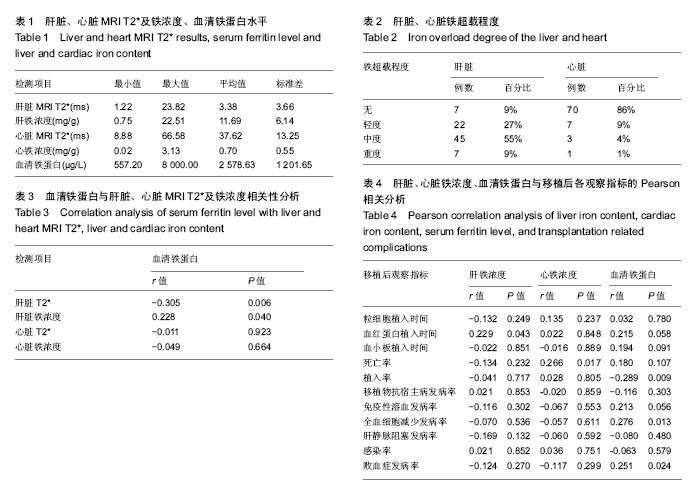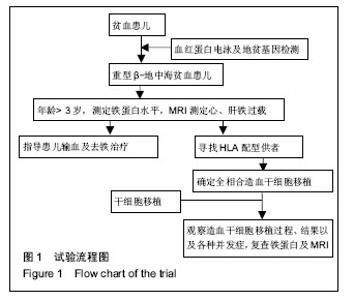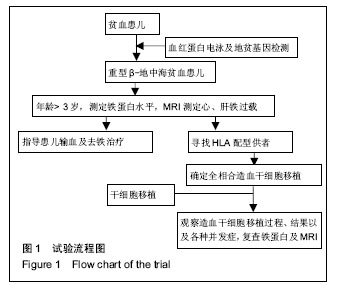Chinese Journal of Tissue Engineering Research ›› 2017, Vol. 21 ›› Issue (33): 5293-5298.doi: 10.3969/j.issn.2095-4344.2017.33.008
Previous Articles Next Articles
Liver and cardiac iron overload is harmful to HLA-identical hematopoietic stem cell transplantation in thalassemia children: an MRI detection
Yang Wen-jing1, 2, Liao Jian-yun1, Wen Jian-yun1, Ruan Yong-sheng1, Chen Li-bai1, He Yue-lin1, Li Chun-fu1,Wu Xue-dong1
- 1Department of Pediatrics, Nanfang Hospital, Southern Medical University, Guangzhou 510515, Guangdong Province, China; 2Department of Pediatrics, Liuzhou Municipal Liutie Central Hospital, Liuzhou 545007, Guangxi Zhuang Autonomous Region, China
-
Revised:2017-09-12Online:2017-11-28Published:2017-12-01 -
Contact:Wu Xue-dong, Chief physician, Department of Pediatrics, Nanfang Hospital, Southern Medical University, Guangzhou 510515, Guangdong Province, China -
About author:Yang Wen-jing, Master, Attending physician, Department of Pediatrics, Nanfang Hospital, Southern Medical University, Guangzhou 510515, Guangdong Province, China; Department of Pediatrics, Liuzhou Municipal Liutie Central Hospital, Liuzhou 545007, Guangxi Zhuang Autonomous Region, China -
Supported by:the Science and Technology Research Project of Guangdong Province, No. 2014A020212186; the President Fund of Nanfang Hospital, No. 2014B012
CLC Number:
Cite this article
Yang Wen-jing, Liao Jian-yun, Wen Jian-yun, Ruan Yong-sheng, Chen Li-bai, He Yue-lin, Li Chun-fu,Wu Xue-dong. Liver and cardiac iron overload is harmful to HLA-identical hematopoietic stem cell transplantation in thalassemia children: an MRI detection[J]. Chinese Journal of Tissue Engineering Research, 2017, 21(33): 5293-5298.
share this article

2.3 肝脏、心脏MRI T2*及铁浓度、血清铁蛋白水平 81例患儿肝脏MRI T2*值为1.22-23.82 ms,平均值为(3.38±3.66) ms,计算出的肝铁浓度为0.75-22.51 mg/g,平均值为(11.69±6.14) mg/g。心脏MRI T2*值为8.88-66.58 ms,平均值为(37.62±13.25) ms,计算出的心铁浓度为0.02-3.13 mg/g,平均值为(0.70±0.55) mg/g。血清铁蛋白检测结果为557.2-8 000 μg/L,平均值为(2 578.63±1 201.65) μg/L,见表1。 按照目前现有的关于重型地中海贫血铁过载的国际共识[16],肝脏轻度铁过载:2.7 ms ≤ 肝脏T2*<6.7 ms,中度铁过载:1.4 ms ≤ 肝脏T2* < 2.7 ms,重度铁过载:肝脏T2* <1.4 ms。心脏轻度铁过载:15 ms ≤ 心脏T2* < 20 ms,中度铁过载:10 ms ≤ 心脏T2* < 15 ms,重度铁过载:心脏T2*<10 ms,81例患儿的肝心铁过载程度见表2。按血清铁蛋白持续>1 000 μg/L诊断铁过载的标准[17],81例重型β-地中海贫血患儿中3例无铁过载,占4%,存在铁过载的有78例,占96%。 2.4 造血重建时间 81例患儿中有3例原发性植入失败,需二次移植,有1例在随访结束时血小板仍未植入。剩余78例中性粒细胞植入时间为11-35 d,中位数18.5 d,平均(19.5±4.83) d。血红蛋白植入时间为1-60 d,中位数14 d,平均(15.45±9.69) d。77例血小板植入时间为7-151 d,中位数14 d,平均(22.32±23.01) d。 2.5 死亡率 81例患儿中共死亡3例,总死亡率为4%。其中1例死于心肌炎、心律失常,1例死于重度移植物抗宿主病,1例死于败血症。 2.6 植入率 81例患儿中共有3例原发性植入失败,总植入率为96%。 2.7 移植后常见并发症 81例患儿中共有14例发生移植物抗宿主病,移植物抗宿主病总发病率为17%,其中Ⅰ度移植物抗宿主病有5例,发病率6%,Ⅱ度移植物抗宿主病有4例,发病率5%,Ⅲ度移植物抗宿主病有2例,发病率2%,Ⅳ度移植物抗宿主病有1例,发病率1%,慢性移植物抗宿主病为2例,发病率为2%;6例患儿发生免疫性溶血,免疫性溶血发病率为7%;81例患儿中共有70例发生不同程度的感染,总感染率86%,其中11例患儿发生败血症,发病率14%;5例患儿发生全血细胞减少,发病率为6%;1例患儿发生肝静脉阻塞病,发病率为1%。 2.8 血清铁蛋白与肝脏、心脏MRI T2*及铁浓度相关性分析 采用Pearson相关分析,血清铁蛋白与肝脏T2*呈负相关(r=-0.305,P=0.006),与肝脏铁浓度呈正相关(r=0.228,P=0.04)。血清铁蛋白与心脏T2*及心铁浓度无明显相关性。见表3。 2.9 肝脏、心脏铁浓度、血清铁蛋白与各指标的相关分析 采用Pearson相关分析,肝脏铁浓度与血红蛋白植入时间呈正相关(r=0.229,P=0.043),即肝铁浓度越高,血红蛋白植入时间越长。而肝铁浓度与其余观察指标均无明显相关性(P > 0.05)。心铁浓度与死亡率呈正相关(r=0.266,P=0.017),即心铁浓度越高,移植后死亡率越高。而心铁浓度与其余观察指标均无明显相关性(P > 0.05)。血清铁蛋白与植入率呈负相关(r=-0.289,P=0.009),血清铁蛋白与败血症发病率呈正相关(r=0.251,P=0.024),血清铁蛋白与全血细胞减少发病率呈正相关(r=0.276,P=0.013),与其他指标无明显相关性。见表4。"

| [1] Behrman RE, Kliegman RM, Jenson HB.尼尔森儿科学[M].17版.北京:北京大学医学出版社,2007.[2] 江载芳,申昆玲,沈颖.诸福棠实用儿科学[M].北京:人民卫生出版社,2015: 1859-1868.[3] Cohen AR, Galanello R, Pennell DJ, et al. Thalassemia. Hematology Am Soc Hematol Educ Program. 2004:14-34.[4] Beutler E, Hoffbrand AV, Cook JD. Iron deficiency and overload. Hematology Am Soc Hematol Educ Program. 2003:40-61.[5] 方建培.铁螯合剂在地中海贫血治疗中的临床应用[J].中国小儿血液与肿瘤杂志,2011,16(6):241-243,255.[6] 张潇予,黄勇.移植前铁过载对血液肿瘤患者异基因造血干细胞移植预后影响的研究进展[J].国际输血及血液学杂志,2014,37(6):538-541.[7] 施圆圆,何祎,冯四洲.铁过载对造血干细胞移植的影响[J]. 白血病•淋巴瘤,2016,25(11):701-704.[8] Pullarkat V, Blanchard S, Tegtmeier B, et al. Iron overload adversely affects outcome of allogeneic hematopoietic cell transplantation. Bone Marrow Transplant. 2008;42(12):799-805.[9] Armand P, Kim HT, Cutler CS, et al. Prognostic impact of elevated pretransplantation serum ferritin in patients undergoing myeloablative stem cell transplantation. Blood. 2007;109(10):4586-4588.[10] Li C, Wu X, Feng X, et al. A novel conditioning regimen improves outcomes in β-thalassemia major patients using unrelated donor peripheral blood stem cell transplantation. Blood. 2012;120(19): 3875-3881.[11] 许兰平,黄晓军.干细胞移植的HLA配型和植入证据检测[J].中国实用儿科杂志,2005,20(11):649-651.[12] Sykes M. Mixed chimerism and transplant tolerance. Immunity. 2001;14(4):417-424.[13] 周小鸽,陈辉树.世界卫生组织肿瘤分类、造血与淋巴组织肿瘤病理学和遗传学[M].北京:人民卫生出版社,2006:7-113.[14] 和虹,邵宗鸿,刘鸿,等.与异常免疫相关的全血细胞减少症[J].中华血液学杂志,2001,22(2):79-82.[15] 葛均波,徐永健.内科学[M].8版.北京:人民卫生出版社,2013:567.[16] Anderson LJ, Holden S, Davis B, et al. Cardiovascular T2-star (T2*) magnetic resonance for the early diagnosis of myocardial iron overload. Eur Heart J. 2001;22(23):2171-2179.[17] Morrison ED, Brandhagen DJ, Phatak PD, et al. Serum ferritin level predicts advanced hepatic fibrosis among U.S. patients with phenotypic hemochromatosis. Ann Intern Med. 2003;138(8):627-633.[18] 李长钢,刘四喜,王缨,等. 重型13地中海贫血患儿心脏及肝脏铁沉积状态的多中心研究[J].中华儿科杂志,2014,52(2):90-93.[19] Kolnagou A, Natsiopoulos K, Kleanthous M, et al. Liver iron and serum ferritin levels are misleading for estimating cardiac, pancreatic, splenic and total body iron load in thalassemia patients: factors influencing the heterogenic distribution of excess storage iron in organs as identified by MRI T2*. Toxicol Mech Methods. 2013;23(1): 48-56.[20] Emond MJ, Bronner MP, Carlson TH, et al. Quantitative study of the variability of hepatic iron concentrations. Clin Chem. 1999;45(3): 340-346.[21] Kataoka K, Nannya Y, Hangaishi A, et al. Influence of pretransplantation serum ferritin on nonrelapse mortality after myeloablative and nonmyeloablative allogeneic hematopoietic stem cell transplantation. Biol Blood Marrow Transplant. 2009;15(2): 195-204.[22] 吴学东,井远方,裴夫瑜,等.磁共振成像(T2*)检测重型地中海贫血患者心脏、肝脏铁负荷及其临床意义[J].南方医科大学学报, 2013,33(2): 249-252.[23] Kirk P, Roughton M, Porter JB, et al. Cardiac T2* magnetic resonance for prediction of cardiac complications in thalassemia major. Circulation. 2009;120(20):1961-1968.[24] 彭鹏,龙莉玲,黄仲奎,等.β-重型地中海贫血MRI定量心脏铁沉积与血清铁蛋白、肝铁浓度相关性研究[J].中华放射学杂志,2012,46(11):993-997.[25] Leung AW, Chu WC, Lam WW, et al. Magnetic resonance imaging assessment of cardiac and liver iron load in transfusion dependent patients. Pediatr Blood Cancer. 2009;53(6):1054-1059.[26] Anderson LJ, Holden S, Davis B, et al. Cardiovascular T2-star (T2*) magnetic resonance for the early diagnosis of myocardial iron overload. Eur Heart J. 2001;22(23):2171-2179.[27] Altes A, Remacha AF, Sarda P, et al. Frequent severe liver iron overload after stem cell transplantation and its possible association with invasive aspergillosis. Bone Marrow Transplant. 2004;34(6):505-509.[28] 柴笑,赵明峰. 铁过载在血液系统疾病中的危害及治疗进展[J].中华内科杂志,2013,52(5):431-433.[29] Tachibana T, Tanaka M, Takasaki H, et al. Pretransplant serum ferritin is associated with bloodstream infections within 100 days of allogeneic stem cell transplantation for myeloid malignancies. Int J Hematol. 2011;93(3):368-374.[30] Weinberg ED. Iron availability and infection. Biochim Biophys Acta. 2009;1790(7):600-605.[31] Bullen JJ, Rogers HJ, Spalding PB, et al. Natural resistance, iron and infection: a challenge for clinical medicine. J Med Microbiol. 2006; 55(Pt 3):251-258.[32] Schaible UE, Kaufmann SH. Iron and microbial infection. Nat Rev Microbiol. 2004;2(12):946-953.[33] Khan FA, Fisher MA, Khakoo RA. Association of hemochromatosis with infectious diseases: expanding spectrum. Int J Infect Dis. 2007;11(6):482-487.[34] Majhail NS, Lazarus HM, Burns LJ. Iron overload in hematopoietic cell transplantation. Bone Marrow Transplant. 2008;41(12):997-1003.[35] Sahlstedt L, von Bonsdorff L, Ebeling F, et al. Non-transferrin-bound iron in haematological patients during chemotherapy and conditioning for autologous stem cell transplantation. Eur J Haematol. 2009;83(5):455-459.[36] Evens AM, Mehta J, Gordon LI. Rust and corrosion in hematopoietic stem cell transplantation: the problem of iron and oxidative stress. Bone Marrow Transplant. 2004;34(7):561-571.[37] von Bonsdorff L, Sahlstedt L, Ebeling F, et al. Apotransferrin administration prevents growth of Staphylococcus epidermidis in serum of stem cell transplant patients by binding of free iron. FEMS Immunol Med Microbiol. 2004;40(2):173-180.[38] Caroline L, Taschdjian CL, Kozinn PJ, et al. Reversal of serum fungistasis by addition of iron. J Invest Dermatol. 1964;42:415-419.[39] Esterly NB, Brammer SR, Crounse RG. The relationship of transferrin and iron to serum inhibition of Candida albicans. J Invest Dermatol. 1967;49(5):437-442.[40] Artis WM, Patrusky E, Rastinejad F, et al. Fungistatic mechanism of human transferrin for Rhizopus oryzae and Trichophyton mentagrophytes: alternative to simple iron deprivation. Infect Immun. 1983;41(3):1269-1278.[41] Modell B, Khan M, Darlison M, et al. Improved survival of thalassaemia major in the UK and relation to T2* cardiovascular magnetic resonance. J Cardiovasc Magn Reson. 2008;10:42.[42] Patton N, Brown G, Leung M, et al. Observational study of iron overload as assessed by magnetic resonance imaging in an adult population of transfusion-dependent patients with beta thalassaemia: significant association between low cardiac T2* < 10 ms and cardiac events. Intern Med J. 2010;40(6):419-426. |
| [1] | Yao Xiaoling, Peng Jiancheng, Xu Yuerong, Yang Zhidong, Zhang Shuncong. Variable-angle zero-notch anterior interbody fusion system in the treatment of cervical spondylotic myelopathy: 30-month follow-up [J]. Chinese Journal of Tissue Engineering Research, 2022, 26(9): 1377-1382. |
| [2] | An Weizheng, He Xiao, Ren Shuai, Liu Jianyu. Potential of muscle-derived stem cells in peripheral nerve regeneration [J]. Chinese Journal of Tissue Engineering Research, 2022, 26(7): 1130-1136. |
| [3] | Zhang Jinglin, Leng Min, Zhu Boheng, Wang Hong. Mechanism and application of stem cell-derived exosomes in promoting diabetic wound healing [J]. Chinese Journal of Tissue Engineering Research, 2022, 26(7): 1113-1118. |
| [4] | He Yunying, Li Lingjie, Zhang Shuqi, Li Yuzhou, Yang Sheng, Ji Ping. Method of constructing cell spheroids based on agarose and polyacrylic molds [J]. Chinese Journal of Tissue Engineering Research, 2022, 26(4): 553-559. |
| [5] | He Guanyu, Xu Baoshan, Du Lilong, Zhang Tongxing, Huo Zhenxin, Shen Li. Biomimetic orientated microchannel annulus fibrosus scaffold constructed by silk fibroin [J]. Chinese Journal of Tissue Engineering Research, 2022, 26(4): 560-566. |
| [6] | Chen Xiaoxu, Luo Yaxin, Bi Haoran, Yang Kun. Preparation and application of acellular scaffold in tissue engineering and regenerative medicine [J]. Chinese Journal of Tissue Engineering Research, 2022, 26(4): 591-596. |
| [7] | Kang Kunlong, Wang Xintao. Research hotspot of biological scaffold materials promoting osteogenic differentiation of bone marrow mesenchymal stem cells [J]. Chinese Journal of Tissue Engineering Research, 2022, 26(4): 597-603. |
| [8] | Shen Jiahua, Fu Yong. Application of graphene-based nanomaterials in stem cells [J]. Chinese Journal of Tissue Engineering Research, 2022, 26(4): 604-609. |
| [9] | Zhang Tong, Cai Jinchi, Yuan Zhifa, Zhao Haiyan, Han Xingwen, Wang Wenji. Hyaluronic acid-based composite hydrogel in cartilage injury caused by osteoarthritis: application and mechanism [J]. Chinese Journal of Tissue Engineering Research, 2022, 26(4): 617-625. |
| [10] | Li Hui, Chen Lianglong. Application and characteristics of bone graft materials in the treatment of spinal tuberculosis [J]. Chinese Journal of Tissue Engineering Research, 2022, 26(4): 626-630. |
| [11] | Gao Cangjian, Yang Zhen, Liu Shuyun, Li Hao, Fu Liwei, Zhao Tianyuan, Chen Wei, Liao Zhiyao, Li Pinxue, Sui Xiang, Guo Quanyi. Electrospinning for rotator cuff repair [J]. Chinese Journal of Tissue Engineering Research, 2022, 26(4): 637-642. |
| [12] | Zhang Jian, Lin Jianping, Zhou Gang, Fang Yehan, Wang Benchao, Wu Yongchang. Semi-quantitative MRI evaluation of cartilage degeneration in early knee osteoarthritis [J]. Chinese Journal of Tissue Engineering Research, 2022, 26(3): 425-429. |
| [13] | Guan Jian, Jia Yanfei, Zhang Baoxin , Zhao Guozhong. Application of 4D bioprinting in tissue engineering [J]. Chinese Journal of Tissue Engineering Research, 2022, 26(3): 446-455. |
| [14] | Liu Jiali, Suo Hairui, Yang Han, Wang Ling, Xu Mingen. Influence of lay-down angles on mechanical properties of three-dimensional printed polycaprolactone scaffolds [J]. Chinese Journal of Tissue Engineering Research, 2022, 10(16): 2612-2617. |
| [15] | Huang Bo, Chen Mingxue, Peng Liqing, Luo Xujiang, Li Huo, Wang Hao, Tian Qinyu, Lu Xiaobo, Liu Shuyun, Guo Quanyi . Fabrication and biocompatibility of injectable gelatin-methacryloyl/cartilage-derived matrix particles composite hydrogel scaffold [J]. Chinese Journal of Tissue Engineering Research, 2022, 10(16): 2600-2606. |
| Viewed | ||||||
|
Full text |
|
|||||
|
Abstract |
|
|||||

